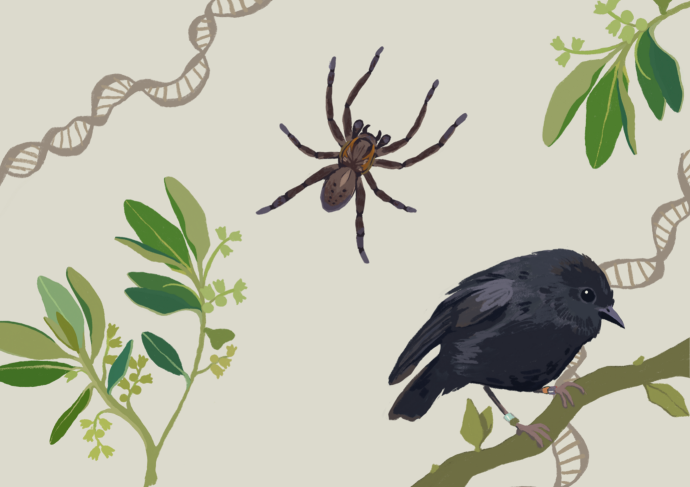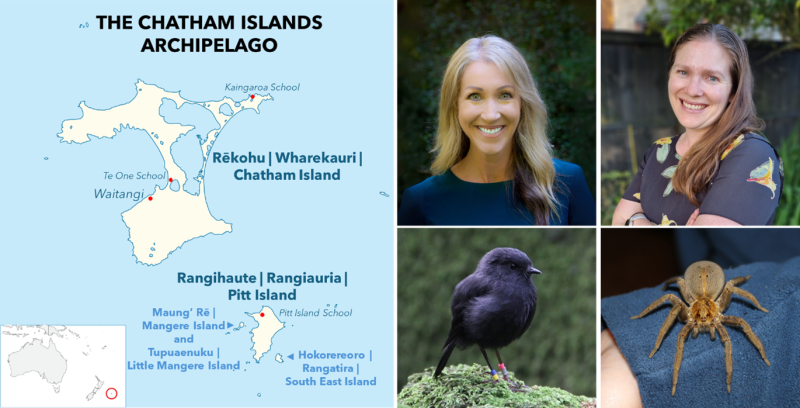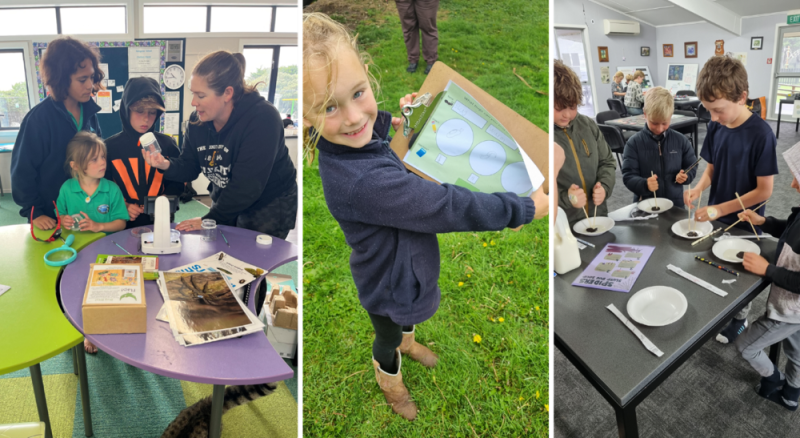Research
Published 30 July 2025Cultivating Connections: Lessons on Community Engagement from the Chatham Islands

Marsden Fast-Start funded researchers Dr Elizabeth Parlato (Te Kunenga ki Pūrehuroa Massey University) and Dr Christina Painting (Te Whare Wānanga o Waikato the University of Waikato) work on very different research questions, but are united by a shared passion for meaningful engagement with communities. Royal Society Te Apārangi kaimahi Dr Olivia Tidswell sat down with them to discuss their ongoing community engagement on the Chatham Islands and how they are championing the importance of connections in science.
Many of the key place/animal names and words in this article are provided in te rē Moriori | te reo Māori | English in the first instance, and then in te rē Moriori thereafter.
Both Dr Elizabeth (Liz) Parlato and Dr Christina (Chrissie) Painting are ecologists - broadly speaking - but beyond that their research interests could hardly be more different. Liz is a population ecologist, who uses modelling to inform the management of some of our most endangered bird species. Chrissie, on the other hand, is a behavioural ecologist, who studies beetles, spiders and other critters to understand how animal mating strategies evolve.
What first brought this duo together was really a fluke of geography - both have Marsden Fast-Start grants that include work on animals endemic to the Chatham Islands. Lying some 800 km off the coast of Ōtautahi Christchurch, the Chatham Islands are a hot-spot for unique flora and fauna. Liz’s Marsden includes work on perhaps the most well-known of the archipelago’s endemic animals, the karure | kakaruia | Chatham Island black robin. Specifically, she and her associate investigator Professor Tammy Steeves (Te Whare Wānanga o Waitaha the University of Canterbury) are studying whether augmenting the smallest population on Maung’ Rē | Mangere | Mangere Island with birds from the larger Hokorereoro | Rangatira | South East Island population improves genetic diversity and population growth. Chrissie is working with a less celebrated local – the Rangatira spider – as part of her Marsden on the diverse mating strategies of Dolomedes fishing spiders.

Left: A map of the Chatham Islands, highlighting some of the locations that Liz and Chrissie visited on Rēkohu | Wharekauri | Chatham Island and Rangihaute | Rangiauria | Pitt Island for community engagement, as well as some of the uninhabited islands where their research is carried out. Map is a modified version of ‘Chatham Islands – blank map’ by Michal Klajban, Wikimedia Commons, CC-BY-4.0. Right: Dr Elizabeth Parlato (left) and Dr Christina Painting (right) are pictured above endemic species of interest for their Marsden grants - the karure | kakaruia | Chatham Island black robin Petroica traversi (left) and the Rangatira spider Dolomedes schauinslandi (right). Photo credits clockwise from top left: David Lupton, Caleb Nicholson, Rose Collen and Kevin Parker.
A chance conversation between Chrissie and Tammy at a Te Pūnaha Matatini writing retreat was what set things into motion. They realised that all three researchers were closely aligned in their values around community engagement, and, in particular, believed in building enduring relationships with the communities closest to their research. This commitment felt especially important for their work in the Chathams. Introduced pests and habitat destruction have eliminated many of the endemic plants and animals from the settled islands of Rēkohu | Wharekauri | Chatham Island and Rangihaute | Rangiauria | Pitt Island. Now, these unique species are restricted to smaller islands designated as conservation reserves, which are very rarely accessible to the public. Liz, Tammy and Chrissie recognised that sharing their research on endemic species with the community could help to nurture connections to their taonga, and encourage local tchimiriki | tamariki | children to pursue careers in science.
Since their first introduction in 2023, the team has visited the Chatham Islands for community engagement several times, joined by various other passionate researchers, students, and their own tchimiriki. Their visits have included engagement with Hokotehi Moriori Trust and Ngāti Mutunga o Wharekauri, events at the three schools across Rēkohu and Rangihaute, and larger public events in Waitangi on Rēkohu. Their most recent visit was themed around “Nature’s Connections”, highlighting the interconnectedness of the natural world and the interdisciplinary nature of science itself. Planning for these events was heavily informed by input from the community. “We received strong messages from teachers that they didn’t want us to just come in and talk at the kids – they wanted something that would actually engage them”, recalled Chrissie. Based on this input, the team designed a number of interactive activities to share their research with the community and ensure interest to all ages. The design and implementation of activities for their most recent trip also benefited from the expertise of teacher Arnaturua Tao, who was hosted by Chrissie as part of the Royal Society Te Apārangi’s Science Leadership Teaching Programme.

The team at Kaingaroa and Te One Schools. Pictured at Kaingaroa School, clockwise starting from left: Arnaturua Tao; Tammy and her son; Liz and her son; Zita Roithmair (Chrissie’s PhD student); Chrissie and her daughter; Kate Moloney (Tammy and Liz’s MSc student); Caleb Teague (Chrissie’s MSc student). Pictured at Te One School from left to right: Arnaturua; Zita, Kate, Tammy’s son and Caleb; Chrissie and her daughter; Tammy and Liz’s son. Photos supplied.
Liz and Chrissie faced very different challenges when thinking about how to translate their research into engaging activities for community engagement. People tend to feel a natural affinity for birds, and many are familiar with the heroic story of Old Blue; getting people interested in karure was therefore not a huge concern for Liz. What was more difficult was translating population monitoring and modelling into fun, interactive activities. Physical props were very helpful for making her work real; DOC was generous enough to lend her one of the original transfer boxes used for transferring the last seven remaining karure from Tapuaenuku | Little Mangere Island to Maung’ Rē in 1976. Kids were able to practise identifying individual birds based on their coloured ID bands, and noting down data to track survival and reproductive success. Liz also produced an interactive spreadsheet model that kids could use to visualise the impact of small changes in reproductive rates on the population size. To explain the importance of DNA data to their project, Tammy took tchimiriki through the process of extracting DNA and showed how it could be used to determine a bird’s sex and to confirm (or deny!) parentage.

Clockwise from top left: Tammy talks DNA with tchimiriki at Pitt Island School; Liz explains her interactive model of karure population growth at Kaingaroa School; Liz and her son with their activity station at The Den. Photos supplied.
Getting people enthused about spiders is a bit more challenging. Rangatira spiders have a particularly fearsome reputation amongst residents due to their large size. Chrissie recalls chatting to a fisherman at a local pub who visibly shivered with fear when talking about them – a couple of weeks earlier, he had stoically navigated a slightly dodgy landing on Maung’ Rē, even helpfully offering to “throw her onto the wave platform” if she was too scared to jump. It was an important reminder about how visceral people’s reactions to spiders can be. Rather than invalidating these feelings, Chrissie tries to encourage people to follow their curiosity by telling weird and wonderful natural history stories. For example, did you know spiders actually digest their prey before they eat them? One of her most popular activities has tchimiriki make their own “bug soup” by mashing up a cookie in milk and sucking it up through a straw. Delicious, but also fascinatingly gross.

From left to right: Chrissie examines a critter with tchimiriki at Kaingaroa School; a Te One pupil shows off their notes on the minibeasts they found on the school field; students from Te One School walk in a spider’s shoes by making their own “bug soup”. Photos supplied.
Implementing public engagement events like this is never easy, but doing so on an isolated archipelago comes with its own special set of challenges. The team couldn’t rely on finding materials and equipment on the island – careful planning and packing was required to make sure they had everything they needed. Even then, there’s a lot that can go wrong when you’re in unfamiliar territory. Chrissie learnt this the hard way after painstakingly laying out pitfall traps in preparation for an event at Kaingaroa school. When she returned the next morning, she found all of the traps had been ripped out of the ground by weka. “The kids weren’t surprised at all”, she laughs. “They said they could have told me that would happen”. She had more success at Te One school after asking the kids for advice on where to put traps down. A good reminder to stay humble and to respect the knowledge of locals!
Weka sabotage aside, Liz and Chrissie’s hard work seems to have made a real impression on the community. Their public engagement events have been described by one resident as “an amazing example of ethical reciprocity”. Liz is particularly proud of the feedback they received from one student, who called them “the coolest scientists we’ve ever had come through”. High praise indeed! What does the team think has been key to making authentic connections with this community?
Firstly, the team are deeply committed to relationship building. This means meeting with locals face to face, taking the time for kōrero, and, crucially, making sure everyone is well fed. As Liz says, “kai is key”. A substantive amount of their community engagement budget was spent on catering for the after school and public events, and they went everywhere equipped with chocolate biscuits for spontaneous chats over a cuppa. Providing food shows respect and care for the community, but also puts people at ease, facilitating more informal conversation. Chrissie also emphasises that their engagement programme started very early, and has taken a long-term, collaborative approach – rather than going in, giving a single, cookie-cutter talk and leaving, they have taken the time to learn what the community wants and improve their activities based on iterative feedback. Their thoughtful, personable approach has opened up new doors for collaboration with the community. For example, Tammy was asked to host rangatahi visiting Te Whare Wānanga o Waitaha the University of Canterbury for the annual Weka Walk in 2024, and Chrissie was invited to be the science advisor for local author Kate Preece’s new children’s book, “The Butterfly Fluttered By”.
They both acknowledge that this kind of reciprocal engagement is not easy in the current funding system. Short-term research grants don’t lend themselves to building and maintaining long-term relationships with communities, and running catered, interactive events isn’t cheap. Liz and Chrissie have so far relied on one-off grants from Te Whare Wānanga o Waitaha the University of Canterbury, Te Pūnaha Matatini and the Brian Mason Scientific and Technical Trust to supplement their Marsden funding, but it’s not clear where the next allocation will come from, especially now that Unlocking Curious Minds has been discontinued.
Liz and Chrissie’s Marsden projects will soon come to an end, but their work in the Chathams is far from over. Both are committed to cultivating the relationships they’ve established beyond the lifetime of a single research grant. This includes their own relationship – the two are now working together directly to inform the management of karure through the Black Robin Advisory Group. Liz has been using population modelling to predict the outcomes of a karure translocation to an inhabited island like Rangihaute – however, a translocation can only be successful if the ecosystem is able to support them. This is where Chrissie comes in. She and her student Caleb Teague are investigating the diet of karure and surveying the abundance of potential prey species (insects and other arthropods) to determine if there is sufficient food available for them to flourish outside of their current range. By weaving together their knowledge on the interconnected ecosystems of Rēkohu, these researchers can inform important management decisions that could make a real difference to the community, reconnecting them with a long-lost taonga.
Community engagement is a powerful approach for inspiring future scientists and fostering an understanding and appreciation of science. By bringing people with different ways of thinking together, it can also inspire new ideas and open doors to unexpected opportunities. “Creating and fostering connections is so important for fulfilling these exciting possibilities” say Liz and Chrissie, who both acknowledge this can only be achieved with continued investment in thoughtful, authentic engagment.
Additional information: Chrissie’s blog post on their first community engagement trip to the Chathams, supported by Te Pūnaha Matatini
RESEARCHER
Dr Elizabeth Parlato and Dr Christina Painting
ORGANISATION
Te Kunenga ki Pūrehuroa Massey University and Te Whare Wānanga o Waikato the University of Waikato
FUNDING SUPPORT
Marsden Fund
CONTRACT OR PROJECT ID
MAU2203 and UOW2201
